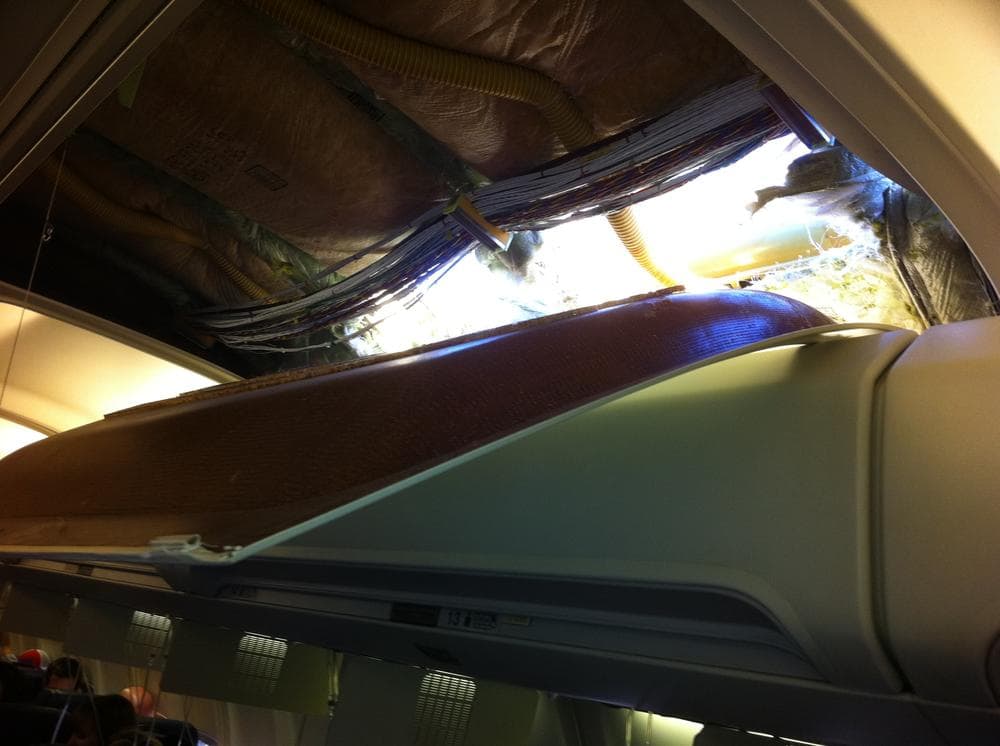Advertisement
Fuselage Hole Forces Southwest Emergency Landing

A "gunshot-like sound" woke Brenda Reese as her Southwest Airlines flight cruised at 36,000 feet. Looking up, she could see the sky through a hole torn in the cabin roof.
The Boeing 737 lost cabin pressure after the hole developed Friday, prompting frightened passengers to grope for oxygen masks as the plane made a terrifying but "controlled descent."
A passenger called it "pandemonium." Another watched as a flight attendant and another passenger passed out, apparently for lack of oxygen, their heads striking the seats in front of them.
Officials said Flight 812 lost pressure because of a fuselage rupture. Federal Aviation Administration spokesman Ian Gregor said the pilot made a "controlled descent from 36,000 feet to 11,000 feet altitude."
His safe emergency landing at a military base in Yuma, about 150 miles southwest of Phoenix, drew applause from relieved passengers.
No serious injuries were reported among the 118 people aboard but a flight attendant was slightly hurt, according to Southwest Airlines. The cause of the hole was not immediately known. The FBI called it a "mechanical failure," not an act of terror or other foul play.
Reese said the plane had just left Phoenix Sky Harbor International Airport for Sacramento, Calif., when the "gunshot-like sound" woke her up. She said oxygen masks dropped as the plane dove.
Seated one row from the rupture, Don Nelson said it took about four noisy minutes for the plane to dip to less than 10,000 feet. "You could tell there was an oxygen deficiency," he said.
"People were dropping," said Christine Ziegler, a 44-year-old project manager from Sacramento who watched as the crew member and a passenger nearby faint. Nelson and Ziegler spoke after a substitute flight took them on to Sacramento.
Advertisement
Reese described the hole as "at the top of the plane, right up above where you store your luggage."
"The panel's not completely off," she told The Associated Press. "It's like ripped down, but you can see completely outside... When you look up through the panel, you can see the sky."
Cellphone photographs provided by Reese showed a panel hanging open in a section above the plane's middle aisle, with a hole of about six feet long.
The National Transportation Safety Board said an "in-flight fuselage rupture" led to the drop in cabin pressure aboard the 15-year-old plane. A similar incident on a Southwest plane to Baltimore in July 2009 also forced an emergency landing when a foot-long hole opened in the cabin.
Four months earlier, the Dallas-based airline had agreed to pay $7.5 million to settle charges that it operated planes that had missed required safety inspections for cracks in the fuselage. The airline, which flies Boeing 737s, inspected nearly 200 of its planes back then, found no cracks and put them back in the sky.
Julie O'Donnell, an aviation safety spokeswoman for Seattle-based Boeing Commercial Airplanes, confirmed "a hole in the fuselage and a depressurization event" in the latest incident but declined to speculate on what caused it.
Reese said passengers applauded the pilot after he emerged from the cockpit following the emergency landing at Yuma Marine Corps Air Station/International Airport.
"It was unreal. Everybody was like they were high school chums," Ziegler said, describing a scene in which passengers comforted and hugged each other after the plane was on the ground.
"I fly a lot. This is the first time I ever had something like this happen," said Reese, a 37-year-old single mother of three who is vice president for a clinical research organization. "I just want to get home and hold my kids."
Gregor said an FAA inspector from Phoenix was en route to Yuma. The NTSB said it also was sending a crew to Yuma.
Holes in aircraft can be caused by metal fatigue or lightning. The National Weather Service said the weather was clear from the Phoenix area to the California border on Friday afternoon.
In 1988, cracks caused part of the roof of an Aloha Airlines Boeing 737 to peel open while the jet flew from Hilo to Honolulu. A flight attendant was sucked out of the plane and plunged to her death, and dozens of passengers were injured.
Three years ago, an exploding oxygen cylinder ripped a gaping hole the fuselage of a Qantas Boeing 747-438 carrying 365 people. The plane descended thousands of feet with the loss of cabin pressure and flew about 300 miles to Manila, where it made a successful emergency landing. No one was injured.
This program aired on April 2, 2011. The audio for this program is not available.